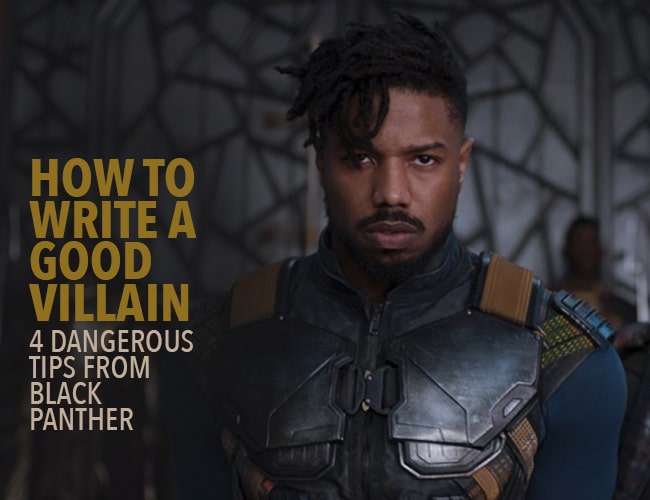A couple of weeks ago, I saw the Marvel blockbuster Black Panther. I’m not a big superhero movie person, but I hear that that they generally involve a hero who saves the world. So imagine my surprise when I left the theater still thinking about Erik Killmonger — the villain.

I was sad for the villain. I was moved by the villain. I wasn’t rooting for him, but could understand why someone might want to. It got me thinking — what made Killmonger such a good villain, and how can that be translated to writing? What can we learn from Black Panther about how to write a good villain?
4 Truths of Great Villains
Here are the four things I learned from Killmonger about how to write a good villain.
1. A Good Villain Is Human
Killmonger wasn’t born evil. He wasn’t completely heartless or soulless. Nor was he a complete psychopath. Killmonger, like most evil people in the world, was a human being hardened by the tough circumstances under which he was raised.
He lost his father, was neglected by his remaining relatives and his birth country, and forced to endure the means streets of Oakland without support. It made him angry and vengeful.
I think the key to depicting your evil character’s humanity is character motivation. You (definitely) and the reader (probably) need to know what drives this person to manipulate, lie, or even kill. How do they rationalize it? Where did they learn to do it?
The author of a good villain knows how the villain got that way.
2. A Good Villain Has Positive Qualities
Killmonger killed. Killmonger cheated. Killmonger wanted to more or less deplete an entire country of its most vital resources.
But he wasn’t all bad. He was smart, well-trained, and strong. He was funny at times and prepared to lead. He also identified a problem that many residents of the mythical nation of Wakanda agreed with (even if they didn’t agree with his solution).
This made him both enjoyable to watch and created tension in moviegoers struggling not to root for him.
As writers, we work hard to show just how evil our villain is, but that doesn’t mean the reader can’t also enjoy the character. Ensuring your villain has a few positive qualities will not only make him or her more nuanced, but it will likely make the reading experience more fun for your audience.
3. A Good Villain Highlights Your Hero’s Dilemma
One of the biggest decisions Black Panther‘s hero, T'Challa, had to make was whether to keep the country he governed, Wakanda, separate from the rest of the world or use its valuable resources to help struggling African nations and people of African descent around the world. T'Challa's love interest and other citizens pressured him to help others and were beginning to view Wakanda as being neglectful and selfish by keeping all of its resources to itself.
Well, (spoiler alert!) Killmonger was literally neglected by T’Challa’s father, who killed Killmonger’s father and then left him to fend for himself in America. For the Black Panther villain, Wakanda's neglect wasn’t theoretical or academic — it was literal, heightening and personalizing the stakes for T’Challa.
Being intentional in the way your villain’s story ties to your hero’s can add depth to both characters and to your story.
4. Your Reader Should Hope the Villain Loses
At the end of the day, no one could really root for Killmonger. He killed dozens of innocent people and wanted to create world-wide anarchy.
I think this was an important piece of his identity. If they made him too relatable or likable, some people would root for him instead of the hero!
If your goal is for the reader to clearly root for your hero, then the villain’s evilness must be made clear. Most, if not all, avenues for redemption must be closed and the correct outcome (in your reader’s eyes) should be for the villain to lose.
A Compelling Villain's Appeal
Ultimately, a story is driven by the villain as much as — if not more than — the protagonist. Black Panther‘s Killmonger is an amazing example of excellent villainy. Integrate these four qualities to make your villain compelling and transform your story.
Who is your favorite villain? Do you have any other tips for how to write a good villain? Let us know in the comments.
PRACTICE
Take fifteen minutes to write a scene from the perspective a villain. Or, write a villain's backstory. Whichever you choose, make sure to integrate at least one of the points above. When you're done, share your writing practice in the comments, and be sure to leave feedback for your fellow writers!



0 Comments